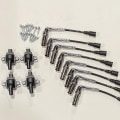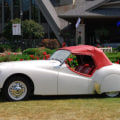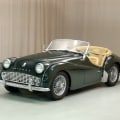The Triumph TR4 was an iconic British sports car that was produced from 1961 to 1965. It was the successor to the popular TR3 and the predecessor to the TR5. The TR4 was a critical success, being praised for its performance and handling. It is also remembered for its classic style, with its long hood, sloping front grille, and distinctive headlights. It was a popular choice among British drivers, and it remains a classic today. This article will take a look at the history of the Triumph TR4. We'll examine how the model came to be, its design features, and its legacy in the automotive world. We'll also discuss the different versions of the TR4, including the limited-edition models.
So, if you're interested in learning more about this classic British sports car, keep reading!The Triumph TR4 was first introduced in 1961 at the Geneva Motor Show. It featured a more modern and angular body than its predecessor, the TR3. The design was penned by Italian designer Giovanni Michelotti, who had previously worked on the designs for other Triumph models such as the Herald and Vitesse. The TR4 was offered with both a hardtop and an open-top version, with the latter being called the TR4A. The car was powered by a 1991 cc inline-four engine, with a four-speed manual transmission and two SU carburetors. was first introduced in 1961 at the Geneva Motor Show. It featured a more modern and angular body than its predecessor, the TR3. The design was penned by Italian designer Giovanni Michelotti, who had previously worked on the designs for other Triumph models such as the Herald and Vitesse. The TR4 was offered with both a hardtop and an open-top version, with the latter being called the TR4A. The car was powered by a 1991 cc inline-four engine, with a four-speed manual transmission and two SU carburetors.
This engine produced around 105 horsepower, giving the car a top speed of around 110 mph (177 km/h). The car also featured independent front suspension and a live rear axle. The interior of the car was well-equipped, with leather upholstery, an adjustable steering wheel, and an adjustable driver's seat. The car also featured wind-up windows and door pockets for added convenience. The Triumph TR4 was offered in several different trim levels, including the standard model, the Special Equipment (SE) model, and the Rallye Special model.
The Special Equipment model featured upgraded interior trim, while the Rallye Special model featured a more powerful engine and stiffer suspension for better performance. The TR4 proved to be quite popular during its production run, with over 40,000 units sold between 1961 and 1965. It also achieved some success in motorsport events such as rallies and hillclimbs. The TR4 was driven to victory in the 1964 Monte Carlo Rally by Timo Mäkinen and Paul Easter. In 1965, the TR4 was replaced by the TR5 model, which featured a six-cylinder engine instead of the four-cylinder engine found in the TR4. The Triumph TR4 was a popular car in its day, being both stylish and well-equipped. It was able to provide drivers with a sporty driving experience while still offering luxury features that made it comfortable for everyday use.
The success of the TR4 can be seen in its sales figures and in its success in motorsport events. It stands as a testament to the quality and innovation of Triumph's vehicles during this era.
Interior Features
The interior of the Triumph TR4 was designed to provide comfort and convenience for the driver and passengers. It featured leather upholstery, an adjustable steering wheel and driver's seat, wind-up windows, and door pockets. The adjustable steering wheel allowed the driver to adjust the steering wheel to a comfortable angle while driving, while the driver's seat could be adjusted to ensure optimal comfort.The wind-up windows provided ventilation for the cabin, while the door pockets offered convenient storage for small items. The TR4 also featured a glove box, which was great for storing personal items, and a heater/defroster to keep the interior warm or cool as needed. The car also had a tachometer, oil pressure gauge, water temperature gauge, fuel gauge, and ammeter. All these features combined to make the TR4 a comfortable and enjoyable driving experience.
Powertrain
1991 cc Inline-Four EngineThe Triumph TR4 was powered by a 1991 cc inline-four engine, which produced 105 horsepower and had a top speed of 115 mph. This engine featured independent front suspension and a live rear axle, providing excellent handling characteristics.Additionally, the TR4 was equipped with two SU carburetors, which provided additional power and torque. The engine was mated to a four-speed manual transmission, providing smooth and quick shifting. The engine in the TR4 was considered to be quite reliable, and provided the car with excellent performance for its day. The combination of the powerful engine and nimble handling made the TR4 a popular choice for sports car enthusiasts in the 1960s.
Trim Levels
The Triumph TR4 was offered in three different trim levels: Standard, Special Equipment (SE), and Rallye Special. The Standard was the base version of the car, with a 1991cc engine, four-speed manual transmission, and two SU carburetors.The Special Equipment (SE) model added more luxurious features, such as leather upholstery, additional chrome trim, and a higher-performance engine. Finally, the Rallye Special was the top-of-the-line model, featuring an even higher performance engine, four-wheel disc brakes, and improved suspension. The Standard trim featured a single-piece windscreen, roll-up windows, and a split rear seat. It was offered with an optional overdrive unit for the transmission that would increase fuel economy. The SE trim added features such as a two-piece windscreen, leather upholstery, and additional chrome trim.
It also featured a higher-performance engine that produced 126 horsepower. The Rallye Special included a number of performance upgrades such as a higher-performance engine with 137 horsepower, four-wheel disc brakes, and improved suspension. It was also offered with an optional overdrive unit for the transmission.
Popularity
The Triumph TR4 was a popular car during its production run, with over 40,000 units sold. This popularity was due to its stylish design and well-equipped features.The TR4 was also successful in motorsport events, such as rallies and hillclimbs. It was a popular choice for racing teams due to its powerful 1991 cc inline-four engine and four-speed manual transmission. The TR4 proved to be a popular choice for hillclimbs and rallies alike. The car was used by multiple teams in the British Saloon Car Championship (BSCC) and the European Rally Championship (ERC) during its production run. The TR4 also proved to be successful in the Monte Carlo Rally, with a podium finish in 1962 and 1963. The car also won the East African Safari Rally in 1967. The popularity of the TR4 model has endured, with many vintage models being restored and driven today.
The TR4 remains a popular choice for classic car enthusiasts due to its attractive design, powerful engine, and motorsport success.
Design
The Triumph TR4 was designed by Italian car designer Giovanni Michelotti, and was an evolution of the earlier TR3 model. Michelotti's design was a distinct departure from its predecessor, giving the TR4 a more modern look with a wider grille and a smoother, curvier body. The TR4 was offered in two body styles: a hardtop and an open-top version, known as the TR4A. The open-top version featured a lower windshield and side curtains instead of roll-up windows. The Triumph TR4 was designed by Italian car designer Giovanni Michelotti, and was an evolution of the earlier TR3 model. Michelotti's design was a distinct departure from its predecessor, giving the TR4 a more modern look with a wider grille and a smoother, curvier body. The TR4 was offered in two body styles: a hardtop and an open-top version, known as the TR4A. The open-top version featured a lower windshield and side curtains instead of roll-up windows.Both body styles were powered by a 1991 cc inline-four engine, with a four-speed manual transmission and two SU carburetors. Giovanni Michelotti's design was a success, helping make the Triumph TR4 one of the most popular sports cars of its day. With its sleek look and powerful engine, the car was a hit with drivers who wanted an attractive car that could also deliver on performance.
Replacement
In 1965, the Triumph TR4 was replaced by the six-cylinder powered TR5 model. The TR5 was an evolution of the earlier TR4, but it featured a more powerful engine with a larger displacement of 2,498 cc.The new engine was capable of producing 150 bhp, which was a significant improvement over the 91 bhp produced by the TR4's 1991 cc engine. Along with the more powerful engine, the TR5 also featured a five-speed manual gearbox and Lucas fuel injection. The TR5 was offered in both hardtop and open-top versions, with the latter being called the TR250. The TR5 was a popular car in its day, as it offered a good combination of performance and style. Despite its popularity, it was only produced for one year before being replaced by the TR6 in 1967. The TR6 also featured a six-cylinder engine, but with a larger capacity of 2,498 cc. The Triumph TR4 was an evolution of the earlier TR3 model that proved to be quite popular during its production run from 1961 to 1965. Offered in both hardtop and open-top versions, it featured a modern angular body designed by Giovanni Michelotti and was powered by a 1991 cc inline-four engine that produced around 105 horsepower.
It also featured a well-equipped interior with leather upholstery and adjustable features. In 1965 it was replaced by the six-cylinder powered TR5 model.


